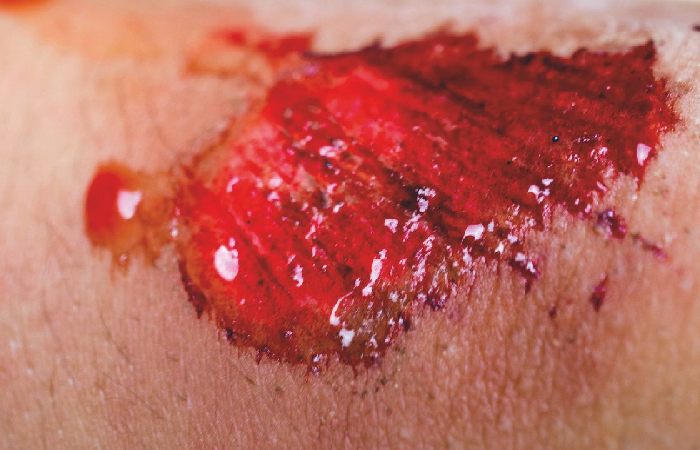Learning update: Focus on wound care
In Clinical
Follow this topic
Bookmark
Record learning outcomes
Superficial damage to the skin occurs often in everyday life and triggers the three-stage process of wound healing: inflammation, proliferation and remodelling. It is important to create the optimal environment for wounds to heal while minimising scar formation.
Effective strategies for wound management need to address the three major wound healing phases simultaneously, focusing specifically on:
- Safeguarding against infection – particularly biofilms, which can form in wound tissue within eight hour
- Modulation of free radicals – these are produced in the skin after injury and help with the wound healing process. Excess levels can interfere with proper wound repair
- Regulation of inflammation – wound healing involves a delicate balance between activation and inhibition of inflammation
- Support of cell proliferation and migration.
One agent with potentially useful applications in minor wound care and scar management is dexpanthenol, a precursor and alcohol analogue of D-pantothenic acid, already contained in a number of personal care products.
Dexpanthenol may assist wound healing in all three stages by modulating inflammation, supporting cell proliferation, and protecting against infection and free radical damage. It is thought to support the remodelling phase and contributes to the prevention of scarring through its hydrating properties.
For more serious wounds, alginate-based aerogels are emerging as promising agents. Aerogels are ultra-light and highly porous materials applied over wounds that can put a quick stop to bleeding, as well as offering important bactericidal properties. They can achieve rapid capture and efficient elimination of bacteria to effectively treat bacterial wound infections due to their high porosity and large surface area.
Cuts and grazes
In the community setting, most commonly occurring wounds such as cuts, grazes and burns are superficial and affect only the outer layers of the skin. For pharmacy teams, advice on how to treat and dress these minor wounds is a key part of the overall first aid offering for customers.
For minor cuts and grazes, the wound should be cleaned first by rinsing with running water and/or using a specialised wound wash, cleansing spray or wound wipe. The aim of cleansing is to remove dirt and any foreign bodies from the wound. Sterile tweezers can be used to extract larger pieces of debris, glass or shallow splinters if required.
The next step is to stop any bleeding by applying gentle pressure for up to five minutes with a clean lint-free cloth or bandage. After drying, a mild antiseptic cream, ointment or gel can then be applied to the wound.
Alternatively, customers may prefer to use one of the range of modern plasters and dressings with build-in antimicrobial ingredients such as silver ions. Application of a dressing or plaster is the key final step in helping to keep the wound clean and protected against infection.
Burning issue
Burns can be caused not only by flames and contact with hot items, but also by electricity, chemicals or sunshine. First-degree burns, where only the epidermis is affected, are the least serious type of burn and most likely to be encountered in the pharmacy setting. The key step in burn treatment is to cool under cold running water for at least 10 minutes or until the pain subsides, before covering with a dressing to prevent infection.
Lotions, creams or ointments should never be used on burns and nor should adhesive dressings unless specifically developed to treat burns.
Traditional adhesive plasters are a staple of any home first-aid kit and useful for minor cuts and grazes. Some plaster brands are billed as ‘fast healing’ and/or ‘scar reducing’ and provide a moist wound healing environment intended to promote quicker healing and reduce scarring compared to traditional dry plasters.
Hydrocolloid plasters and dressings work on a similar principle and help to create the optimum conditions for a wound to heal with no hard scab formation.
Spray plasters are an alternative to adhesive plasters, creating an instant, transparent and waterproof protective layer over the wound. For larger wounds, low adherent dressings (e.g. melolin secured with adhesive tape) or adhesive wound dressings that are self-securing offer protection and keep the wound clean.
Skin closures may be required for deeper cuts but should be used with caution on elderly people or anyone predisposed to thinning skin.
Burns should be covered with a sterile gauze bandage or a clean, lint-free dressing; gauze-impregnated dressings or vapour permeable films may also be used. Specialised burn plasters are now also available containing a hydrogel layer intended to reduce scarring.
Red flags & referrals
It is important to be alert to situations where a wound cannot be safely self-treated and further medical attention is required. This includes cuts that are particularly deep or long (more than half an inch) and/or where the bleeding does not stop after five minutes of applied pressure.
Wounds with a foreign object embedded within them, such as a piece of glass, may also not be amenable to OTC treatment. Customers whose injury was caused by an animal or human bite, or where contamination with dirt/bacteria is probable (e.g. a puncture wound from a rusty nail), may require medical investigation and even a tetanus injection (especially if they have not had a booster within the past 10 years).
For burns and scalds, any wound larger than three to four inches in diameter and/or with severe blistering or skin discolouration, should be referred.

